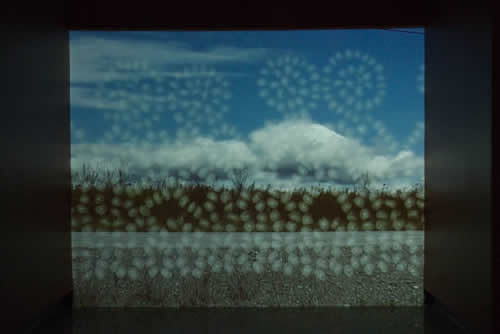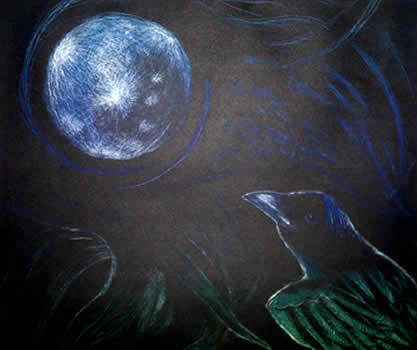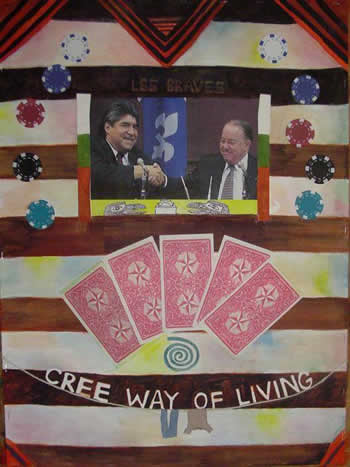
Back to archives | Back to FOFA Gallery
|
May 20 - June 14
IZHIZKAWE: TO LEAVE TRACKS TO A CERTAIN PLACE: AN EXHIBITION OF
CONCORDIA’S INDIGENOUS ALUMNI
The intent of organizing an exhibition of Concordia’s Indigenous
alumni reaches far beyond a desire to recognize a group of artists
from a particular “ethnic” background, shared heritage or visible
minority status. Although the difficulties of negotiating what
is fundamentally a Western, mainstream institution for students
who come from outside those cultural and social parameters are
significant; this exhibition is a recognition of the emergence
of a contemporary movement grounded in Indigenous values, aesthetic
sensibilities and conceptual frameworks, and the role Concordia
alumni have played in that emergence.
The enrollment of First Nations, Inuit and Metis artists at Concordia
University’s Faculty of Fine Arts has been proportionately low
over the years, but the small but steady stream of graduating artists
and curators have had a considerable impact on curatorial and arts
practice both within and outside of Canada. In fact my own perception,
based on this impact, was of a much larger group. From the students
who formed Nation to Nation, a Montreal based artist collective
in the late 1990’s, to representation in groundbreaking exhibitions
such as Indigena, this group of artists and curators have collectively
combined innovative practice with a steadfast commitment to using
their artistic voice and aesthetic expression as a tool for decolonization,
activism and healing. Izhizkawe alludes to the tracks left by each
individual graduate, creating a path for those who have followed.
Some walked the path alone, perhaps catching a glimpse of someone
just before them, others were able to create small artistic communities. However they experienced the path, it would seem they arrived at the
same place. The research for this project identified thirteen graduates
from the Bachelor of Fine Arts, Master of Fine Arts and Master
of Arts in Art History programs. Twelve were able to participate
in this exhibition, and all of them maintain a vibrant arts practice.
This alone makes them remarkable, as the attrition rate among Fine
Arts graduates is well known.

In terms of group demographics, the
majority of alumni are rooted in eastern territories: Skawennati
Tricia Fragnito (Kahnawake),
Ryan Rice (Kahnawake), Wahsontiio Suzanne Cross (Kahnawake), Katsi’tsakwas
Ellen Gabriel (Kahnesata:ke), Hannah Claus (Tyendinaga), Jean Pierre
Pelchat (James Bay Cree) and Nadia Myre (Algonquin, Maniwaki).
Six of these artists currently live in southern Quebec, most in
Montreal or their home territories. Jason Baerg, Julie Flett, KC
Adams and Catherine Mattes are Metis/Cyborg Hybrids whose families
originate from the northern plains and western lake country. Eric
Robertson and Arthur Renwick are Haisla from the North West Coast
of British Columbia.
The artist who broke the trail was Anishnabekwe Janice Toulouse
Chartrand who graduated from the MFA program in 1985. Born on the
Serpent River First Nation in northern Ontario, a descendant of
hereditary chiefs, including Chief Shingwauk, Janice embraces the
honors and responsibilities that come with that legacy, as does
Katsi’tsakwas Ellen Gabriel, whose role as spokesperson and negotiator
during the 1990 Oka crisis is etched on the memories of Canadians
who remember that summer. Toulouse Chartrand works as an arts educator,
teaching drawing at North Island Campus and the Emily Carr Institute.
Ellen Gabriel’s continued role as community activist is currently
focused on language preservation and her responsibilities as the
elected president of Femmes Autochtones du Quebec/Quebec Native
Women. Despite a demanding schedule, Gabriel continues her arts
practice, and with fellow alumni Hannah Claus, is among the artists
in Ryan Rice’s current touring exhibition Oh So Iroquois!

A commitment to community, in terms of residency and advocacy,
is shared by all alumni. Several continue to reside on their First
Nations territory, while others are deeply invested in urban Aboriginal
communities. Jean Pierre Pelchat lives in Chisasibi in northern
Quebec, where he returned to teach in 2003. Wasontiio Cross, who
graduated in 2007, curated a beadwork exhibition this past summer
for the museum in Kahnawake’s historic St. Francois Xavier church,
and is currently doing arts programming at community daycares.
Catherine Mattes lives in rural southwestern Manitoba, but continues
to work as an independent curator and Aboriginal arts animateur
with Mentoring Artists for Women’s Art (MOWA) in Winnipeg. KC Adams
was program coordinator at Urban Shaman Gallery in Winnipeg, Manitoba,
and is currently an artist instructor for Learning Through the
Arts. Julie Flett spent five years working on Vancouver’s East
Side as a coordinator for a First Nations’ Visual Communication
Program and women’s advocate and support worker. Her current work as a children’s book illustrator is an extension
of her commitment to literacy and cultural concerns in urban centres.
Ellen Gabriel has turned her talents to illustrating Mohawk language
curriculum materials. Nadia Myre’s projects (Beading the Indian
Act and The Scar Project) directly engage community in collective
acts of creation, resistance and healing.
Alumni activism has also had a considerable impact in the larger
arena of Aboriginal arts within Canada’s borders and beyond. In
1994 Skawennati Tricia Fragnito, Ryan Rice and Eric Robertson established
Nation to Nation, an artist collective primarily composed of Concordia-based
students. Reaching out to fellow students KC Adams, Arthur Renwick,
Julie Flett and Catherine Mattes, Nation to Nation projects included
Tattoo Nation, Cyber Pow Wow, and Native Love. From the outset,
Nation to Nation looked outwards, seeking partnerships and connections
with other Indigenous artists and arts communities, museums and
galleries. Cyber Pow Wow (1996), curated by Skawennati Fragnito,
announced the arrival of Indigenous artists in cyber space and
digital production. However, Native Love proved to be the curatorial
vehicle that launched the participants onto the national scene.
It had an extraordinary life, touring Canada from 1996 to 2005.
Nation to Nation remained active until 2005, and group members
continue to collaborate in a variety of projects and exhibitions. This time period also marked
the high water mark in terms of Indigenous enrolment at Concordia,
and any sense of collectivity. More recent alumni have found their
experiences more solitary, but have found their way into the larger
network. Ryan Rice is one of the founding members of the Aboriginal
Curatorial Collective, where alumni can be found among the national
and international membership.
Concordia alumni have had an impact at The Indian Art Centre, Department
of Indian and Northern Affairs Canada, the Urban Shaman Gallery
in Winnipeg, Manitoba as staff, board members and exhibiting artists.
Hannah Claus is artistic director of the artist-run centre AXE-NEO
7 in Gatineau, while Jason Baerg is the development coordinator
at the Centre for Indigenous Theatre in Toronto. During 2007-2008
Ryan Rice, Nadia Myre, Catherine Mattes and KC Adams participated
in artist and curatorial residencies and fellowships at The Banff
Centre.
As evidenced by the growing list of international exhibitions,
guest lectures and residencies, the work of this group gets attention.
Land, both as sovereign territory and sacred place, is one of the
common threads. Emerging from that foundation are references to
language, history, and identity. Traditional beliefs and conceptual
frameworks are frequently evoked in both curatorial and artistic
practice. Collectively the work teases, soothes, confronts. Humour
and beauty are the slight-of-hand that cloak a quick punch to the
solar plexus of unsuspecting audiences drawn to comic figures,
bright colours or delicate renderings. There is no vanishing presence
here. This work is all about arrival, survivance and beyond.
Dr.
Sherry Farrell Racette,
Guest Curator
Sherry Farrell Racette is of First Nations and Irish ancestry and
is a member of Timiskaming First Nation. She was born and raised
in Manitoba, where she began her career in Aboriginal education
as a teacher of Native Studies and Art. From her time as a teacher,
to her work as an outreach artist in First Nations and Métis communities,
Farrell Racette has integrated her arts practice with community.
Working as a classroom teacher, consultant, and teacher educator,
she has been involved in numerous research and curriculum initiatives
ranging from Aboriginal youth issues, First Nations and Métis history,
Aboriginal art history and art education. Over the course of her
career, she has been a faculty member at the Métis controlled Gabriel
Dumont Institute’s teacher education program (SUNTEP), the Faculty
of Education at the University of Regina and the Department of
Indian Education at First Nations University of Canada. She has
served on numerous boards including the Saskatchewan Heritage Foundation
Board, the Saskatchewan Arts Board, Sakewewak Artists Collective, Regina Plains Museum,
and the Aboriginal Research Council at the University of Winnipeg.
Farrell Racette has worked extensively in museum collections, examining
material culture as encoded objects that carry history, story and
knowledge. She has a particular interest in revitalizing traditional
art forms, and increasing the recognition and appreciation of contemporary
traditional artists and their practice.

Artist websites:
KC Adams
http://www.kcadams.net/
Jason Baerg
http://www.jasonbaerg.com
http://www.stormspirits.ca/plaintruth
Janice Toulouse Chartrand
http://homepage.mac.com/jtoulouse/
Skawennati Fragnito
http://www.skawennati.net
Nadia Myre
www.nadiamyre.com |
|

